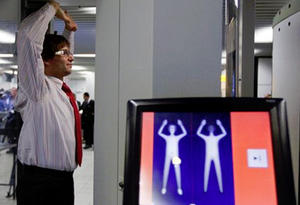New questions raised about full-body scanners
Aviation security experts say the machines may miss items that metal detectors catch; airline passengers may also be able to hide materials in the groin or body cavities; critics do not dispute that the imaging technology is superior to metal detectors at finding hidden nonmetallic objects, but some say it should be used only in conjunction with metal detectors and other technologies

Demonstration of full-body scanner // Source: katu.com
In the wake of the attempted Christmas Day airline bombing, the Transportation Security Administration (TSA) decided to double its investment in the new machines, with a goal of installing 450 across the country by the end of the year, 950 by the end of 2011, and 1,800 by 2014.
The machines are best-known for the privacy issues they pose, because they can peer through clothes and present screeners with an image that some have likened to a virtual strip search. The government has addressed those concerns by obscuring the faces of those being screened, preventing examiners from seeing the passengers, and allowing the option of a physical pat down.
Ken Dilanian writes in the Los Angeles Times that TSA has not been able to ease concerns among some aviation security specialists about the body imagers. “I can overcome the body scanners with enough explosives to bring down a Boeing 747,” said Rafi Sela, former chief security officer at the Israel Airport Authority, who is now a security consultant (see “Security specialist: Canada’s new airport security scanners a waste of money,” 23 April 2010 HSNW).
The TSA would not talk about specific capabilities but says the body imagers will better enable screeners to find nonmetallic weapons, including concealed powdered and liquid explosives that do not set off metal detectors. “No technology is going to be the silver bullet, but this is a significant enhancement,” said Robin Kane, assistant administrator for the TSA’s Office of Security Technology.
Officials hastened deployment of the scanners after Nigerian Umar Farouk Abdulmutallab allegedly smuggled a powdered explosive sewn in his underwear onto a Detroit-bound flight from Amsterdam last Christmas, but failed to detonate it.
Stephen M. Lord of the Government Accountability Office (GAO) told Congress in March, however, that the TSA’s classified testing shows it is unclear whether the technology would have detected Abdulmutallab’s bomb.
The GAO also noted that unlike metal detectors, the body imagers rely on TSA employees to accurately read the image, as they must do with X-ray images of carry-on bags.
Dilanian quotes Clark Ervin, former DHS inspector general, to say that classified tests show that X-ray screeners routinely miss threats. The rate of detection for baggage X-rays is “disastrously low, and it’s
